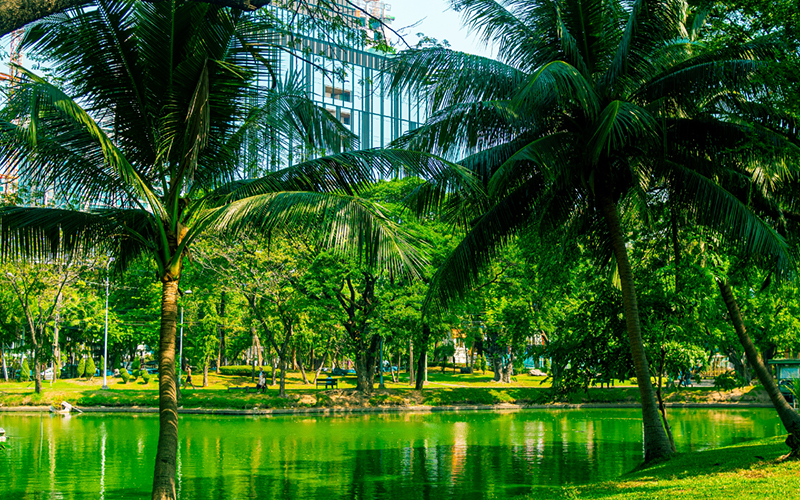Build green to help fend off the next pandemic
Investments in climate-resilient infrastructure should be the centerpiece of the billions of dollars in economic stimulus being used to rebuild Asia’s economies.
Governments across the world including our region, Asia and the Pacific, are struggling to stem a rising tide of infection. For many of us, this will forever remain the memory of 2020. The question now is - will the memory of 2025 or 2028 look similar, or will we learn from Covid-19 to make real change for an improved version of the “new normal”.
| “Greening” Asia’s cities will make them more resilient to future pandemics. Photo: Vitalijs Barilo |
The Old Normal: Struggling to balance human and natural capital. The “old normal” struggled to maintain the balance between the environment, people and economies, and came with a high risk of epidemics and other natural disasters. While growing economies and rising wealth have benefited millions, this region is also associated with entrenched fossil fuel dependence and increasing greenhouse gas emissions, decreasing primary forests and vanishing species, and a never-ending stream of plastic going into the ocean. Storms, drought, tsunamis and even volcanoes are par for the course for people living in Southeast Asia, where many of us live and work. And in the end, the loss in balance between nature and people also spurred the rise and spread of the coronavirus disease.
Preventing the next Covid will require a serious rethink of how we develop our economies especially in Asia and the Pacific. And the starting point for this is infrastructure development, which is key to any post-Covid economic recovery effort, helping to kickstart economies, create jobs and keep businesses afloat.
Recovery financing must go into green infrastructure. Infrastructure also lies at the crux of balancing economic, social and environmental sustainability, as infrastructure projects are still associated with potentially major impacts on climate, oceans and forests, and biodiversity. With an estimated US$210 billion in investment needed per year for infrastructure in Southeast Asia alone, ensuring this investment is targeted towards the cleanest and most sustainable options will be critical in a post-Covid future.
Greening post-Covid infrastructure investment will require concerted action across policy, governance, capacity and finance domains in the long-term. But most immediately, one practical step decision-makers can take is to put in place principles that are practical and quickly implemented to help guide infrastructure choices and ensure they are green.
Such principles are not new. Global, regional and national “green bond” standards help distinguish bonds that support green objectives from those that don’t. In the last two years alone, major efforts by the European Union, the People’s Republic of China and others to establish specific lists or ‘taxonomies’ on what is green have taken the discussion a step further.
The Climate Bonds Standard, for example, sets out criteria for different project types to help investors determine their impact. A solar or wind project would almost always automatically classify as ‘green’, whereas a project to support bus systems in a city would only count after considering the type – and associated environmental footprint – of the buses in question.
Green finance principles must build in financial incentives. In addition to calculating the green impact, public incentives need to help green projects become bankable, especially ones that may be associated with more expensive technologies. Green finance principles that link cheaper financing or incentives with climate and environmental criteria are key to moving infrastructure trajectories in Asian countries from “brown” to “green”.
Such an approach is being piloted under the ASEAN Catalytic Green Finance Facility, a multi-government-owned (all ASEAN region countries) green finance vehicle in the region, managed by ADB. The facility has published investment principles to screen projects based on green criteria as well as bankability conditions, and links this to cheaper financing.
The timing of the release of the ASEAN Catalytic Green Finance Facility’s principles during the Covid-19 pandemic is hopefully also a ringing bell for decision makers who are struggling to weigh their options in designing their post-Covid economic recovery packages.
Investments in climate-resilient infrastructure that help to maintain natural capital and protect oceans should be the centerpiece for the billions of dollars in economic stimulus being considered. Greening post-Covid recovery can spur industry and maintain jobs, but can also help us stave off and build resilience for the next major shock or crisis that hits.
In the long-term, hopefully, a greener, more balanced growth pathway in the Asia Pacific region will become our ‘new normal’.
Anouj Mehta is Unit Head, Green and Innovative Finance and the ACGF, Southeast Asia Department, ADB.
Naeeda Crishna Morgado is Senior Climate Finance Specialist (Consultant), ACGF, ADB.











